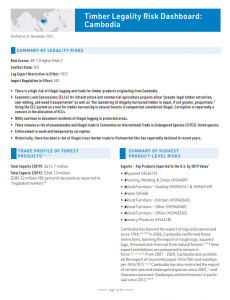Timber Legality Risk Dashboard: Cambodia
By Forest Trends View PublicationCambodia has seen high rates of forest loss over the last few decades. Between 1973 and 1993 the country saw an annual rate of forest loss of approximately 0.5 percent. Such losses were reportedly caused by commercial logging and 30 years of civil war and political instability.49 As deforestation rates continued to increase, the government banned log exports in 1996, joined the Convention on International Trade in Endangered Species of Wild Fauna and Flora (CITES) in 1997 and instituted a concession system. Between 1994 and 1997, the government granted 36 forest concessions that collectively covered 7 million hectares. Reports have estimated that 95 percent of the timber harvested between 1997 and 1998 was illegally felled. The government of Cambodia adopted a logging moratorium in 2002. The restrictions did not apply to other types of concessions in the country. Timber may be sold or exported from agriculture and infrastructure concessions, as well as community forestry areas, social land concessions and privately owned or managed plantations.
Cambodia lost almost 2.5 million hectares of tree cover between 2001 to 2020, a 28 percent loss in tree cover since 2000. The annual rate of loss increased by more than 400 percent over the same period with nearly 150,000 ha of loss occurring in 2020 alone, of which nearly half (43 percent) was to natural forest.

